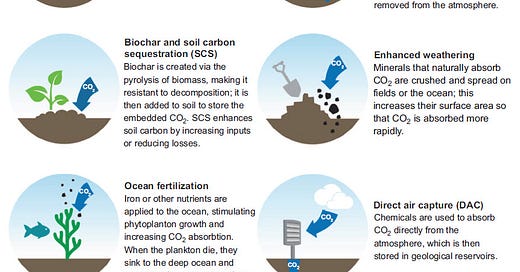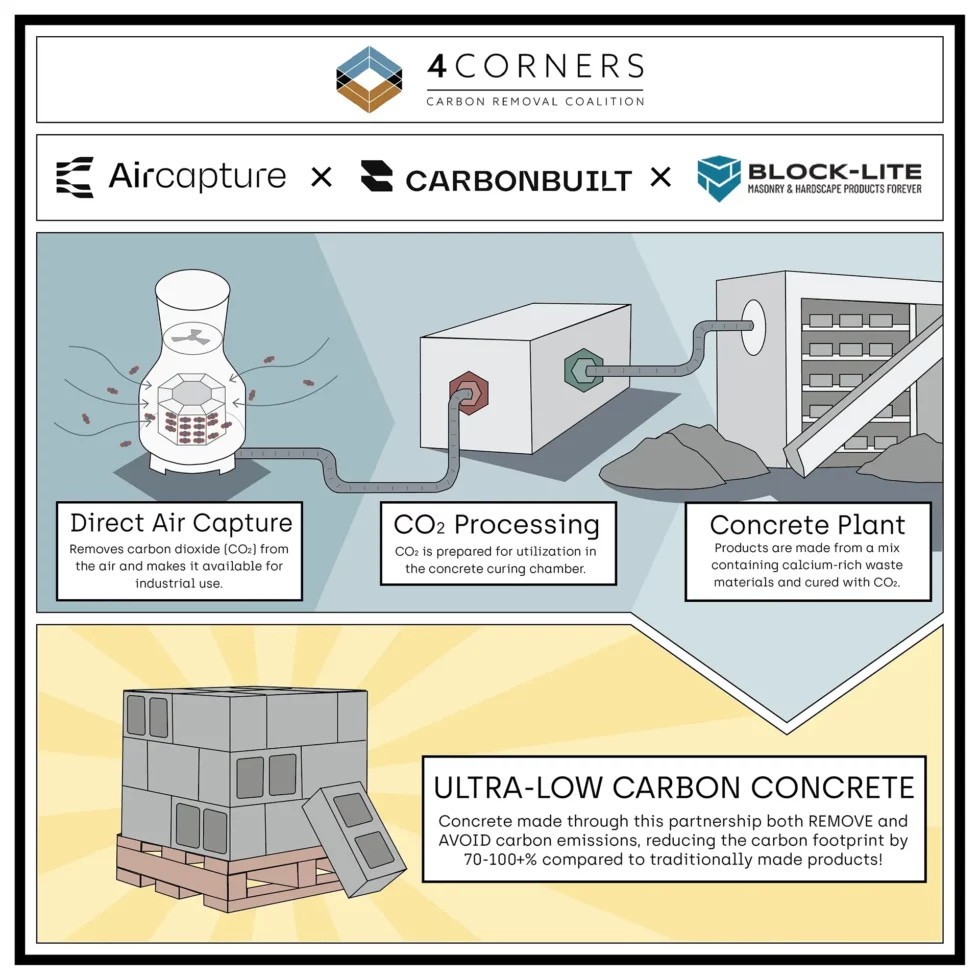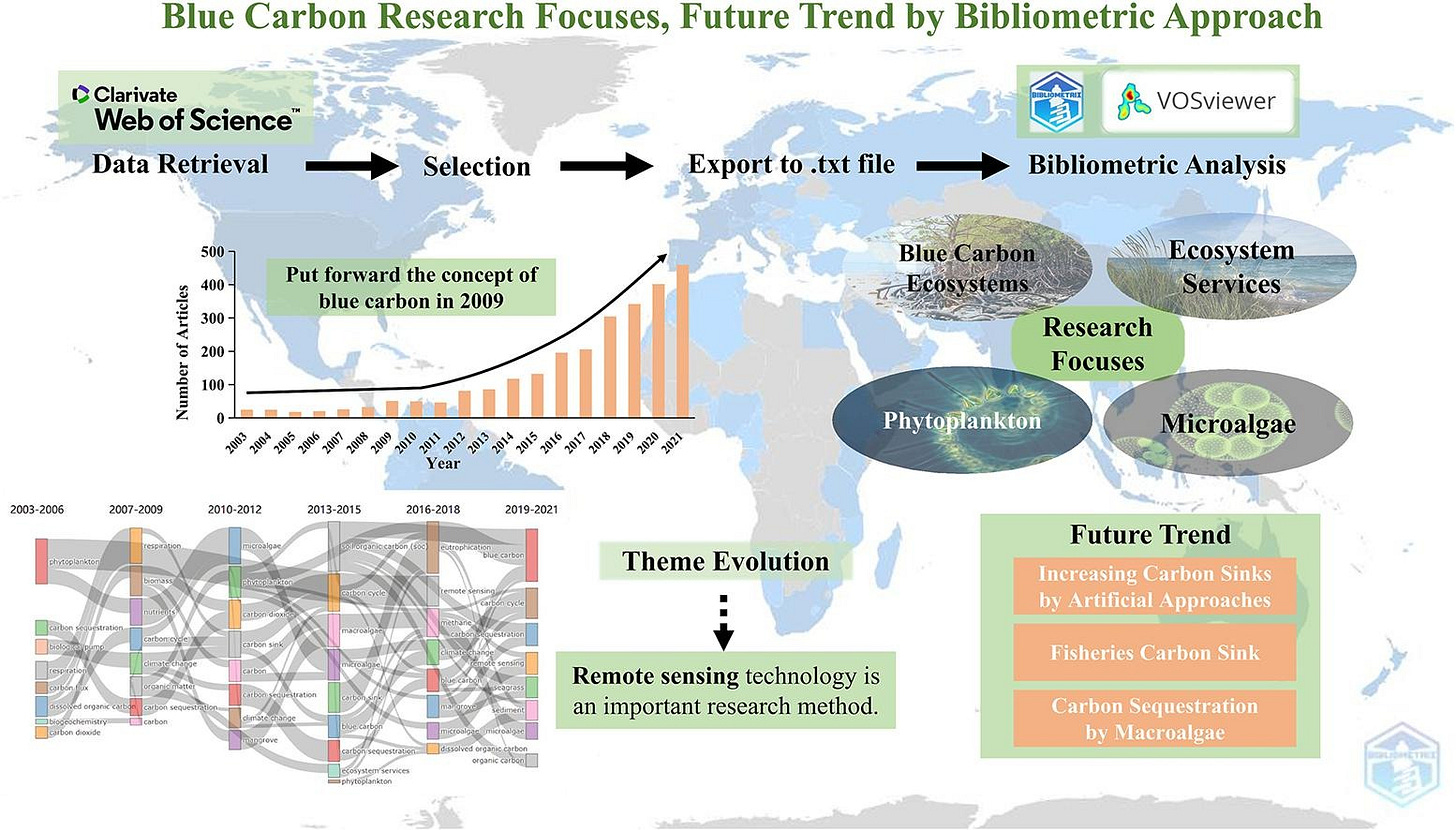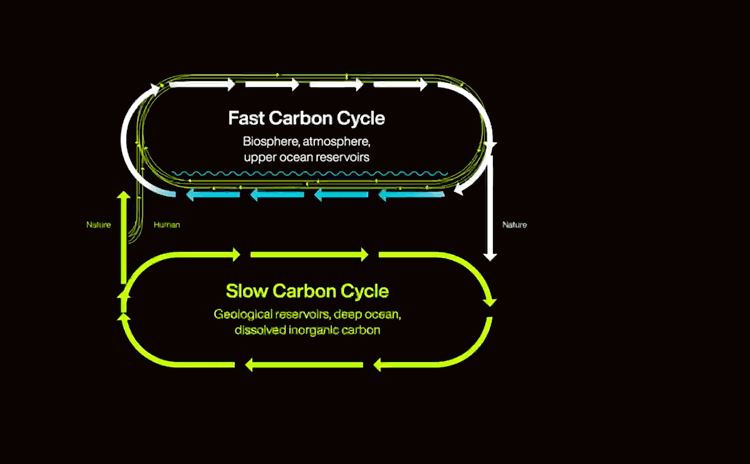WEEKLY SUMMARY (6 MARCH - 12 MARCH 2023) - WEEK#3
Recent scientific papers, web posts, upcoming events, job opportunities, podcasts and videos etc.) on Carbon Dioxide Removal Technology.
COMMERCIAL NEWS
Innovation grants awarded to four concrete production projects
CSIRO Launches $20 Million Negative Emissions Technologies Program
SCIENTIFIC PAPERS
Influence of enhanced silicate weathering on microbial processes and soil carbon formation in agricultural soil
Probabilistic feasibility assessment of sequestration reliance for climate targets
Net zero and the unexplored politics of residual emissions
Evaluation of direct air capture technologies for climate change mitigation based on a multi-criteria decision-making approach and life cycle assessment
Application of Digital Twin For Direct Air Capture
Fairness and feasibility in deep mitigation pathways with novel carbon dioxide removal considering institutional capacity to mitigate
Direct air capture (DAC) and sequestration of CO2: Dramatic effect of coordinated Cu(II) onto a chelating weak base ion exchanger
Diverse carbon dioxide removal approaches could reduce impacts on the energy–water–land system
Potential of ocean calcifiers to sequester atmospheric carbon in quantity and even reverse climate change
Deep-sea impacts of climate interventions
Options for carbon sequestration in the Solent Region
The formative phase of German carbon dioxide removal policy: Positioning between precaution, pragmatism and innovation
Climate impact of bioenergy with or without carbon dioxide removal: influence of functional unit and parameter variability
Addition of Alkalinity to Rivers: a novel strategy for Ocean Alkalinity Enhancement
A systematic overview, trends and global perspectives on blue carbon: A bibliometric study (2003–2021)
Assessing the response of particulate matter stoichiometry to ocean alkalinity enhancement
Assessing the impact of CDR on the power system
Enhanced Weathering of Olivine in Rivers for Carbon Dioxide Removal
Permanence of soil applied biochar: Conclusions from the natural pyrogenic carbon cycle validate carbon sink accounting
WEB POSTS
EU and UN Kickstart Their Work on Carbon Removal for 2023
White Paper - Sustainably Amplifying the Natural Carbon Cycle
The role of animals in carbon removal
Baker Hughes And HIF Global Collaborate On Direct Air Capture Technology
RUNNING TIDE BECOMES MICROSOFT'S FIRST OPEN OCEAN-BASED CARBON REMOVAL SUPPLIER
Countries are relying on forests and soil to absorb their remaining carbon – it’s a risky way to reach net zero
Biggest carbon credit certifier to replace its rainforest offsets scheme
The acid test: taking carbon dioxide removal to the community (Learnings from a community feedback session on ocean alkalinity enhancement)
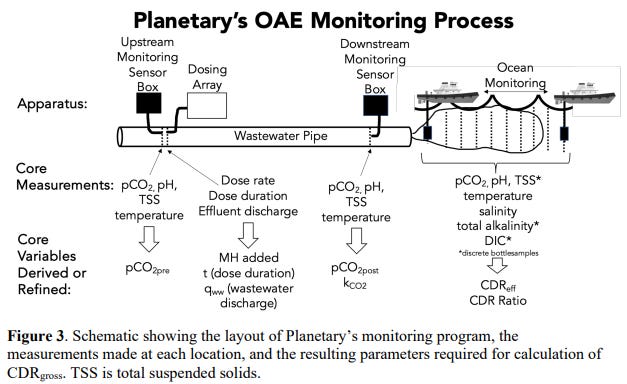
Highlights From EU’s First Expert Group Meeting On The Carbon Removal Certification Framework
Undersea graveyard for imported CO2 opens in Denmark
BOOK
CO2-philic Polymers, Nanocomposites and Chemical Solvents
REPORTS
Ocean-based carbon dioxide removal landscape in China
The low-carbon label (A French approach to improving the voluntary market for emissions reductions and removals)
DISCUSSIONS
45Q for DAC
Artificial Upwelling—A false Narrative
UPCOMING EVENTS
Scrubbing the Skies: Certifying Soil Carbon Removals by Institute for Carbon Removal Law and Policy | 14 March 2023
Going Carbon Negative | A Webinar on the Future Potential of Carbon Removal Technologies | 14 March 2023
Geochemical CDR, Frontiers | 15 March 2023
CDR Swiss Webinar: Deep-Dive USA by Swiss Carbon Removal Platform | 16 March 2023
Webinar: Spotlight on US policy and maritime CDR | 16 March 2023
Join the first global dialogue on carbon removal | 16 March 2023
Nature-based Carbon Removal Methods by SJN Climate Primer | 17 March 2023
Scripps Oceanography & PNNL: Marine Decarbonization Initiatives | 17 March 2023
Removing CO₂ from the air - learn about the direct air capture pioneer | 21 March 2023
Carbon Removal at Scale: A Call to Action from the IPCC Report | 23 March 2023
Net Zero Latest and the Role of Carbon Removal by Sustainable Business Network | 24 March 2023
Ocean-Based Contributions to Carbon Dioxide Removal by AGU | 4-5 April 2023
THE Carbon Removal Business Summit of 2023 by Carbon Unbound | 11-12 May 2023
TEA/LCA Workshop on Harmonizing CCUS Assessments by The Global CO2 Initiative | 17-18 May 2023
The 12th Trondheim Conference on CO2 Capture, Transport and Storage by CCS Research Centre (NCCS) | June 19 - 21, 2023
JOB OPPORTUNITIES
Job openings at UNDO
“We’re on a mission to remove a billion tonnes of CO₂ from our atmosphere by 2030.”
Sales manager at Myno Carbon
“Myno Carbon’s mission is to remove as much carbon as we can, as fast as we can to mitigate climate change. To meet this goal, Myno is building large-scale carbon removal facilities (CRFs) that convert sustainability sourced timber waste into biochar and renewable electricity. Once built, Myno’s first CRF in northeast Washington state will be the largest biochar production facility in the US. Myno is actively developing biochar sales pathways within our core biochar sales segments including agricultural inputs, potting media, horticulture, and animal feed, among others.”
Head of Carbon at Kita
“Carbon insurance is what we do. In fact, it’s all we do.
This single mindedness enables us to build an insurance company that offers tailored insurance products to all parties - buyers, sellers, intermediaries - across the carbon market. By keeping our brief laser-focused, we can offer insurance policies that are rooted in research, constantly re-calibrated as we acquire new data and based on the expertise that we and our partners pride ourselves on.”
Senior Manager, Novel CDR Business at the South Pole
“South Pole is an energetic, global company offering comprehensive sustainability solutions and services. With offices spanning all continents across the globe, we strive to create a sustainable society and economy that positively impacts our climate, ecosystems and developing communities. With our solutions, we inspire and enable our customers to create value from sustainability-related activities.”
DEADLINES
The Call for Abstracts for the 20th International Conference on Carbon Dioxide Utilization | 15 March 2023
Scouring the web to learn carbon removal? 6-week sprint to rapidly learn carbon removal by AirMiners | 20 March 2023
Competition: Carbon to Value Initiative (Year-3) | March 31st, 2023
Technology areas include, but are not limited to:
Carbon Capture, such as atmospheric (e.g. DAC) or point source from flue gas (esp. from hard-to-decarbonize sectors.
Carbon Conversion to Added-Value Products, such as CO2 mineralization into building materials, CO2 conversion to fuels (e.g. SAF), and chemicals (and related feedstocks like syngas)
Carbon Dioxide Removal (CDR), such as ocean alkalinity enhancement, enhanced rock weathering, etc.
Enabling Technologies, such as Measurement, Reporting and Verification (MRV) systems for carbontech (software and/or hardware), financing and insurance, carbon markets
Applications open for OCB Working Group on Marine Carbon Dioxide Removal (mCDR) | 14 April 2023
Research Topic- Carbon dioxide removal: Perspectives from the social sciences and humanities (Call for submission of abstract and manuscript) | Abstract Submission Deadline 10 April 2023 and Manuscript Submission Deadline 28 August 2023
FUNDING OPPORTUNITIES
Opportunity: BIL Regional Direct Air Capture Hubs | Due Date: 13 March 2023
Direct Air Capture Prizes
DAC Pre-Commercial EPIC Prize | Submission Deadline: 20 March 2023
DAC Pre-Commercial Technology Prize | Submission Deadline: 20 March 2023
DAC Commercial Prize | Submission Deadline: 20 March 2023
U.S. Department of Energy Announces $45 Million to Validate Marine Carbon Dioxide Removal Techniques through scalable Measurement, Reporting and Validation (MRV) technologies | Status: Active
RFP for Innovative Carbon Dioxide Removal Projects by Climate Vault | Due Date: 29 March 2023
Cost Share for Federal Clean Energy Funding Opportunities, Carbon Removal Innovation Support Program | Ongoing
PODCASTS
Financial Innovation within Carbon Removal (& EHR!)—w/ Peter Olivier, Head of New Markets at UNDO | Nori
“Peter Olivier is Head of New Markets at UNDO, a company that uses enhanced rock weathering to achieve carbon removal at scale. On this bonus episode of Reversing Climate Change, Peter joins Ross and Siobhan to describe the UNDO process, discussing the source of the rock UNDO uses, and why they partner with farmers to spread crushed rock on cropland. Peter shares his take on the forward contract basis of the CDR market, exploring ‘the uncomfortably large amounts of money’ we need to scale and how we might make CDR forwards contracts more fungible. Listen in for Peter’s insight on innovating CDR markets through donor-advised funds and find out how we might be able to influence the future by creating opportunities to finance carbon removal at scale!”
Regulating Ocean CDR Research | Nori
“The Canadian company Planetary is currently seeking regulatory approval to release Magnesium Hydroxide into the ocean off the coast of Cornwall, England. Another ocean CDR firm, Running Tide, announced last week that they are partnering with global consulting giant Deloitte to evaluate the quality of their carbon credits. Last month, a research team at MIT received news coverage for their ocean carbon capture technique which they say is a breakthrough that is more effective than direct air capture. These recent announcements indicate real and widespread interest in researching techniques that pull CO2 from the ocean. But how is research into these approaches governed? And what important regulatory issues have yet to be resolved, that will have a big impact on the climate? On this episode, we’ll take a look at the state of ocean CDR research governance with one of the field’s foremost experts, Wil Burns. Wil talks us through some the main international agreements that govern the seas, and experiments within them. What does existing law mean for plans to test ocean CDR?”
Foresting the deserts – Caldera | Reviewer 2 does geoengineering
“Is it practical and sensible to turn deserts into forests, using desalination & irrigation? Upeksha Caldera discusses her new paper with @geoengineering1. Paper "Afforesting arid land with renewable electricity and desalination to mitigate climate change" (https://www.nature.com/articles/s41893-022-01056-7).”
YOUTUBE VIDEOS
There's a playlist with more videos on the topic, you can check it out.
There's a playlist by Ocean Carbon & Biogeochemistry OCB on the topic OCB's mCDR Workshop
Carbon Removal: A NYS Congressional Delegation Briefing | OpenAir
“A 1-hour webinar hosted by OpenAir for New York State Congressional Delegation staff covering Carbon Removal science, economic opportunity and policy needs.”
Carbon catch-up | The business case for carbon removal | With Shopify | Climeworks
Key takeaways:
“Without more corporate demand, the carbon removal market won’t scale to the level that is necessary for companies, and the world, to reach net zero in the coming decades.
On that path to achieve climate impact, corporate buyers of carbon removal are securing future capacity and mitigate risks by anticipating regulatory changes in the carbon market.
Additionally, businesses who act now boost their climate leadership and build up their knowledge to navigate a complex industry.
With the due diligence process that has been done by Shopify and others, early buyers today are in a good position to identify high-quality carbon removal solutions.”
How To Register and Certify Carbon Removal Credits | AirMiners
“Getting carbon credits recognized by registries is a key step in developing a carbon removal company. So for this panel, we are going to explore how an entrepreneur got certification for her carbon removal credits, and also add a buyer's perspective on what they look for in certifications.”
C2GTalk: How can companies ensure carbon dioxide removal has a positive impact? | C2G Carnegie Climate Governance Initiative
“New thinking is needed to ensure high-quality nature-based carbon dioxide removal offers genuine and long-lasting benefits to the climate and biodiversity, said Amy Luers, Global Director for Sustainability Science at Microsoft Corporation during a C2GTalk. Large-scale removal through CDR technologies lies further ahead, although most of the basic technologies already likely exist. While Ms. Luers is not in favor of pursuing solar radiation modification, “I am very much in favor of enhancing our understanding of the risks and opportunities it presents, the governance challenges, and how decisions are made around this.”
The Massive Machines Removing Carbon from Earth's Atmosphere | Jan Wurzbacher | TED
“To restrain global warming, we know we need to drastically reduce pollution. The very next step after that: using both natural and technological solutions to trap as much excess carbon dioxide from the air as possible. Enter Orca, the world's first large-scale direct air capture and storage plant, built in Iceland by the team at Climeworks, led by climate entrepreneur Jan Wurzbacher. This plant is capable of removing 4,000 tons of carbon dioxide from the air each year. With affordability and scalability in mind, Wurzbacher shares his vision for what comes after Orca, the future of carbon capture tech -- and why these innovations are crucial to stop climate change.”
Carbominer – New and Efficient CO₂ Direct Air Capture Technology | Carbominer
“Carbominer develops an efficient and sustainable technology to capture CO₂ locally from the ambient air. Direct Air Capture of CO₂ is a proven mean for the companies to reach net-zero goals by using a carbon removal mechanism or by transition to sustainable operations when switching to fossil-free CO₂ as a feedstock. Carbominer's main competitive advantages are the ability to set the affordable price per ton of CO₂ due to the transportability of the capturing modules, usage of electrochemistry for CO₂ regeneration and ability to harness the intermittent renewable energy. This short animation helps to understand how Carbominer combines a mix of dry and wet capture with electrochemistry-based pH-swing.”
Geoengineering Oceans to Slow Global Warming | Bloomberg Originals
“Oceans naturally absorb huge amounts of carbon dioxide, and efforts to harness that power are gaining in popularity. In Norway, we meet a group of scientists trying to change ocean alkalinity in order to supercharge its CO2 appetite, though the impact on ecosystems remains unknown. In Morocco, the company Brilliant Planet has opted instead to grow CO2-absorbing algae. But with previous experiments yielding mixed-results, can they deliver on their promises?”
Biotechnology and Natural Carbon Removal Pathways: Panel discussion from CTRF Funding launch webinar | CTRFoundationUK
CTRF Call for Research Proposals - February 2023 | CTRFoundationUK
“CTRF Call for Proposals - now open!.”
Can we trick the ocean into swallowing more CO2? | DW Planet A
“Marine environments are effective at capturing carbon and storing it for thousands of years. But what if we could engineer them to capture even more? Can they take on this burden?”

